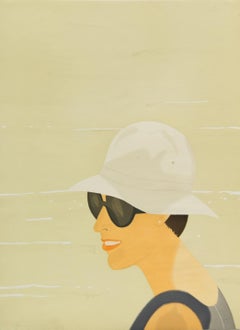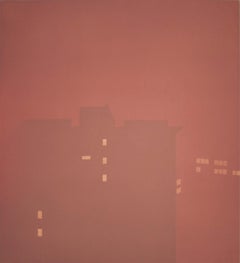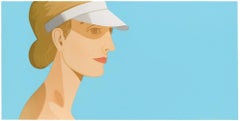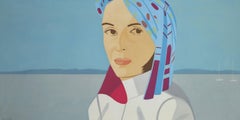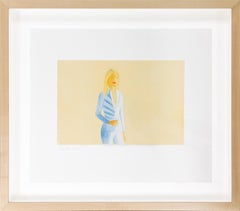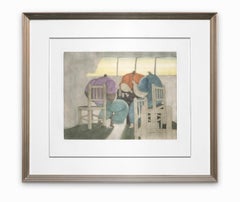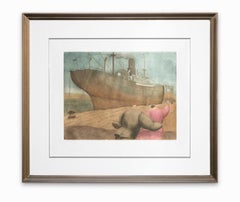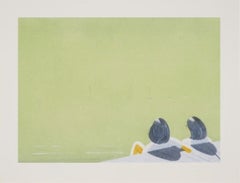Art by Medium: Aquatint
to
2
1
8
Overall Width
to
Overall Height
to
3
8
3
11
4
1
7
4
9
8
3
3
3
2
2
2
2
1
1
1
1
1
1
1
1
1
1
1
3,236
65
58
36
26
271
46
37
34
26
1
4
9
2
Style: Contemporary
Medium: Aquatint
Artist: Alex Katz
Margit Smiles
By Alex Katz
Located in New York, NY
signed and numbered lower image
edition 7/40
Catalogue raisonné 00269
Internationally recognized painter and printmaker Alex Katz was born in 1927 in Brooklyn, New York. Over a thir...
Category
1990s Contemporary Art by Medium: Aquatint
Materials
Aquatint
$30,000
Rowboat
By Alex Katz
Located in New York, NY
Although best known for his portraits, Katz has depicted landscapes both inside the studio and out of doors since the beginning of his career. This print of a boat on the water feat...
Category
1990s Contemporary Art by Medium: Aquatint
Materials
Aquatint
$10,000
New Year's Eve
By Alex Katz
Located in New York, NY
Catalogue raisonné 00594
edition 16/43
Published by Simmelink-Sukimoto Editions
Although best known for his portraits, Katz has depicted landscapes both inside the studio and out o...
Category
1990s Contemporary Art by Medium: Aquatint
Materials
Aquatint
White Visor
By Alex Katz
Located in Miami, FL
TECHNICAL INFORMATION
Alex Katz
White Visor
2003
Etching Aquatint
33 3/8 x 66 7/8 in.
Edition of 75
Pencil signed & numbered
Accompanied with COA by Gregg Shienbaum Fine Art
...
Category
Early 2000s Contemporary Art by Medium: Aquatint
Materials
Aquatint, Etching
$55,000
Ada in Blue Hat - 2004 - Aquatint in 11 colors - Portrait of Ada Katz in Maine
By Alex Katz
Located in Miami, FL
Ada in Blue Hat
2004
Aquatint in 11 colors
33 1/2 x 67 in.
Edition of 75
Pencil signed and numbered
With flat planes of rich, lovely color, Alex Katz’s landscapes and portraits evok...
Category
21st Century and Contemporary Contemporary Art by Medium: Aquatint
Materials
Aquatint
Sissel (VII/XX/-50 Arabic Numerals + Roman Numerals)
By Alex Katz
Located in Fort Lauderdale, FL
Alex Katz was born in Brooklyn, New York in 1927. In 1928, at the outset of the Depression, his family moved to St. Albans, a diverse suburb of Queens that had sprung up between the two wars. Katz was raised in St. Albans by his Russian parents. His mother had been an actress and possessed a deep interest in poetry and his father, a businessman, also had an interest in the arts. Katz attended Woodrow Wilson High School for its unique program that allowed him to devote his mornings to academics and his afternoons to the arts. In 1946, Katz entered The Cooper Union Art School in Manhattan, a prestigious college of art, architecture, and engineering. At The Cooper Union, Katz studied painting under Morris Kantor and was trained in Modern art theories and techniques. Upon graduating in 1949, Katz was awarded a scholarship for summer study at the Skowhegan School for Painting and Sculpture in Maine, a grant that he would renew the following summer.
During his years at Cooper Union, Katz had been exposed primarily to modern art and was taught to paint from drawings. Skowhegan exposed him to painting from life, which would prove pivotal in his development as a painter and remains a staple of his practices today. Katz explains that Skowhegan’s plein air painting gave him “a reason to devote my life to painting.” Katz’s first one-person show was held at the Roko Gallery in 1954. Katz had begun to develop greater acquaintances with the New York School and their allies in the other arts; he counted amongst his friends’ figurative painters Larry Rivers and Fairfield Porter, photographer Rudolph Burckhardt, and poets John Ashbery, Edwin Denby, Frank O’Hara, and James Schuyler. From 1955 to 1959, usually following a day of painting, Katz made small collages of figures in landscapes from hand-colored strips of delicately cut paper.
In the late 1950s, he moved towards greater realism in his paintings. Katz became increasingly interested in portraiture, and painted his friends and his wife and muse, Ada. He embraced monochrome backgrounds, which would become a defining characteristic of his style, anticipating Pop Art and separating him from gestural figure painters and the New Perceptual Realism. In 1959, Katz made his first cutout, which would grow into a series of flat “sculptures;” freestanding or relief portraits that exist in actual space.
In the early 1960s, influenced by films, television, and billboard advertising, Katz began painting large-scale paintings, often with dramatically cropped faces. In 1965, he also embarked on a prolific career in printmaking. Katz would go on to produce many editions in lithography, etching, silkscreen, woodcut and linoleum cut. After 1964, Katz increasingly portrayed groups of figures.
He would continue painting these complex groups into the 1970s, portraying the social world of painters, poets, critics, and other colleagues that surrounded him. He began designing sets and costumes for choreographer Paul Taylor in the early 1960s, and he has painted many images of dancers throughout the years. In the 1980s, Katz took on a new subject in his work: fashion models in designer clothing. In the late 1980s and 1990s, Katz focused much of his attention on large landscape paintings, which he characterizes as “environmental.” Rather than observing a scene from afar, the viewer feels enveloped by nearby nature. Katz began each of these canvases with “an idea of the landscape, a conception,” trying to find the image in nature afterwards. In his landscape paintings, Katz loosened the edges of the forms, executing the works with greater painterliness than before in these allover canvases. In 1986, Katz began painting a series of night pictures—a sharp departure from the sunlit landscapes he had previously painted, forcing him to explore a new type of light. Variations on the theme of light falling through branches appear in Katz’s work throughout the 1990s and into the 21st century.
At the beginning of the new millennium, Katz also began painting flowers in profusion, covering canvases in blossoms similar to those he had first explored in the late 1960s, when he painted large close-ups of flowers in solitude or in small clusters. More recently Katz began painting a series of dancers and one of nudes, which was the subject of a 2011 exhibition at the Kestnergesellschaft in Hanover. Katz’s work continues to grow and evolve today. Alex Katz's work has been the subject of more than 200 solo exhibitions and nearly 500 group exhibitions internationally since 1951. In 2010, Alex Katz Prints was on view at the Albertina Museum in Vienna, which showed a retrospective survey of over 150 graphic works from a recent donation to the museum by Katz of his complete graphic oeuvre. The National Portrait Gallery in London presented an exhibition titled Alex Katz Portraits.
In June 2010, The Farnsworth Art Museum in Rockland, Maine opened Alex Katz: New Work, exhibiting recent large-scale paintings inspired by his summers spent in Maine. Katz was also represented in a show at the Metropolitan Museum of Art, New York, curated by Marla Prather, entitled Facing the Figure: Selections from the Permanent Collection, 2010. In 2009-2010, Alex Katz: An American Way Of Seeing was on view at the Sara Hildén Art Museum, Tampere, Finland; Musée Grenoble, Grenoble, France; and the Museum Kurhaus Kleve, Kleve, Germany. In 2007, Alex Katz: New York opened at the Irish Museum of Modern Art, Dublin, Ireland. The show, which included approximately 40 paintings and aquatints, was the first exhibition to concentrate primarily on Katz’s relationship with his native city.
The Jewish Museum, New York, presented Alex Katz Paints Ada in 2006-2007, an exhibition of 40 paintings focused on Katz’s wife, Ada, dating from 1957 to 2005. It coincided with an exhibition devoted to Katz’s paintings of the 1960s at PaceWildenstein, Alex Katz: The Sixties, on view from April 27 through June 17, 2006 at 545 West 22nd Street. Alex Katz in Maine, an exhibition of landscapes and portraits made over six decades, opened at The Farnsworth Art Museum and Wyeth...
Category
Early 2000s Contemporary Art by Medium: Aquatint
Materials
Aquatint
Price Upon Request
Blue Hat (28/75)
By Alex Katz
Located in Fort Lauderdale, FL
Alex Katz was born in Brooklyn, New York in 1927. In 1928, at the outset of the Depression, his family moved to St. Albans, a diverse suburb of Queens that had sprung up between the two wars. Katz was raised in St. Albans by his Russian parents. His mother had been an actress and possessed a deep interest in poetry and his father, a businessman, also had an interest in the arts. Katz attended Woodrow Wilson High School for its unique program that allowed him to devote his mornings to academics and his afternoons to the arts. In 1946, Katz entered The Cooper Union Art School in Manhattan, a prestigious college of art, architecture, and engineering. At The Cooper Union, Katz studied painting under Morris Kantor and was trained in Modern art theories and techniques. Upon graduating in 1949, Katz was awarded a scholarship for summer study at the Skowhegan School for Painting and Sculpture in Maine, a grant that he would renew the following summer.
During his years at Cooper Union, Katz had been exposed primarily to modern art and was taught to paint from drawings. Skowhegan exposed him to painting from life, which would prove pivotal in his development as a painter and remains a staple of his practices today. Katz explains that Skowhegan’s plein air painting gave him “a reason to devote my life to painting.” Katz’s first one-person show was held at the Roko Gallery in 1954. Katz had begun to develop greater acquaintances with the New York School and their allies in the other arts; he counted amongst his friends’ figurative painters Larry Rivers and Fairfield Porter, photographer Rudolph Burckhardt, and poets John Ashbery, Edwin Denby, Frank O’Hara, and James Schuyler. From 1955 to 1959, usually following a day of painting, Katz made small collages of figures in landscapes from hand-colored strips of delicately cut paper.
In the late 1950s, he moved towards greater realism in his paintings. Katz became increasingly interested in portraiture, and painted his friends and his wife and muse, Ada. He embraced monochrome backgrounds, which would become a defining characteristic of his style, anticipating Pop Art and separating him from gestural figure painters and the New Perceptual Realism. In 1959, Katz made his first cutout, which would grow into a series of flat “sculptures;” freestanding or relief portraits that exist in actual space.
In the early 1960s, influenced by films, television, and billboard advertising, Katz began painting large-scale paintings, often with dramatically cropped faces. In 1965, he also embarked on a prolific career in printmaking. Katz would go on to produce many editions in lithography, etching, silkscreen, woodcut and linoleum cut. After 1964, Katz increasingly portrayed groups of figures.
He would continue painting these complex groups into the 1970s, portraying the social world of painters, poets, critics, and other colleagues that surrounded him. He began designing sets and costumes for choreographer Paul Taylor in the early 1960s, and he has painted many images of dancers throughout the years. In the 1980s, Katz took on a new subject in his work: fashion models in designer clothing. In the late 1980s and 1990s, Katz focused much of his attention on large landscape paintings, which he characterizes as “environmental.” Rather than observing a scene from afar, the viewer feels enveloped by nearby nature. Katz began each of these canvases with “an idea of the landscape, a conception,” trying to find the image in nature afterwards. In his landscape paintings, Katz loosened the edges of the forms, executing the works with greater painterliness than before in these allover canvases. In 1986, Katz began painting a series of night pictures—a sharp departure from the sunlit landscapes he had previously painted, forcing him to explore a new type of light. Variations on the theme of light falling through branches appear in Katz’s work throughout the 1990s and into the 21st century.
At the beginning of the new millennium, Katz also began painting flowers in profusion, covering canvases in blossoms similar to those he had first explored in the late 1960s, when he painted large close-ups of flowers in solitude or in small clusters. More recently Katz began painting a series of dancers and one of nudes, which was the subject of a 2011 exhibition at the Kestnergesellschaft in Hanover. Katz’s work continues to grow and evolve today. Alex Katz's work has been the subject of more than 200 solo exhibitions and nearly 500 group exhibitions internationally since 1951. In 2010, Alex Katz Prints was on view at the Albertina Museum in Vienna, which showed a retrospective survey of over 150 graphic works from a recent donation to the museum by Katz of his complete graphic oeuvre. The National Portrait Gallery in London presented an exhibition titled Alex Katz Portraits.
In June 2010, The Farnsworth Art Museum in Rockland, Maine opened Alex Katz: New Work, exhibiting recent large-scale paintings inspired by his summers spent in Maine. Katz was also represented in a show at the Metropolitan Museum of Art, New York, curated by Marla Prather, entitled Facing the Figure: Selections from the Permanent Collection, 2010. In 2009-2010, Alex Katz: An American Way Of Seeing was on view at the Sara Hildén Art Museum, Tampere, Finland; Musée Grenoble, Grenoble, France; and the Museum Kurhaus Kleve, Kleve, Germany. In 2007, Alex Katz: New York opened at the Irish Museum of Modern Art, Dublin, Ireland. The show, which included approximately 40 paintings and aquatints, was the first exhibition to concentrate primarily on Katz’s relationship with his native city.
The Jewish Museum, New York, presented Alex Katz Paints Ada in 2006-2007, an exhibition of 40 paintings focused on Katz’s wife, Ada, dating from 1957 to 2005. It coincided with an exhibition devoted to Katz’s paintings of the 1960s at PaceWildenstein, Alex Katz: The Sixties, on view from April 27 through June 17, 2006 at 545 West 22nd Street. Alex Katz in Maine, an exhibition of landscapes and portraits made over six decades, opened at The Farnsworth Art Museum and Wyeth...
Category
2010s Contemporary Art by Medium: Aquatint
Materials
Archival Paper, Aquatint
Price Upon Request
Yellow Flags 4 - 21st Century, Alex Katz Landscape Print, Orang, Yellow, Flowers
By Alex Katz
Located in Köln, DE
Yellow Flags 4 - 21st Century, Alex Katz Landscape Print, Orange, Yellow, Flowers,
"Yellow Flags 4" is one of Alex Katz's famous flower prints. His flowers are the most reduced form...
Category
2010s Contemporary Art by Medium: Aquatint
Materials
Etching, Aquatint
Beauty 5 - etching, black and white, Katz, Ada, sunglasses
By Alex Katz
Located in Köln, DE
"Beauty 5" is from Alex Katz' Beauty series. The topic "beauty" is a very important one for Katz. His whole body of work is due to beauty and it is a reminiscence to his wife Ada, to...
Category
2010s Contemporary Art by Medium: Aquatint
Materials
Etching, Aquatint
White Visor
By Alex Katz
Located in Fort Lauderdale, FL
Alex Katz was born in Brooklyn, New York in 1927. In 1928, at the outset of the Depression, his family moved to St. Albans, a diverse suburb of Queens that had sprung up between the two wars. Katz was raised in St. Albans by his Russian parents. His mother had been an actress and possessed a deep interest in poetry and his father, a businessman, also had an interest in the arts. Katz attended Woodrow Wilson High School for its unique program that allowed him to devote his mornings to academics and his afternoons to the arts. In 1946, Katz entered The Cooper Union Art School in Manhattan, a prestigious college of art, architecture, and engineering. At The Cooper Union, Katz studied painting under Morris Kantor and was trained in Modern art theories and techniques. Upon graduating in 1949, Katz was awarded a scholarship for summer study at the Skowhegan School for Painting and Sculpture in Maine, a grant that he would renew the following summer.
During his years at Cooper Union, Katz had been exposed primarily to modern art and was taught to paint from drawings. Skowhegan exposed him to painting from life, which would prove pivotal in his development as a painter and remains a staple of his practices today. Katz explains that Skowhegan’s plein air painting gave him “a reason to devote my life to painting.” Katz’s first one-person show was held at the Roko Gallery in 1954. Katz had begun to develop greater acquaintances with the New York School and their allies in the other arts; he counted amongst his friends’ figurative painters Larry Rivers and Fairfield Porter, photographer Rudolph Burckhardt, and poets John Ashbery, Edwin Denby, Frank O’Hara, and James Schuyler. From 1955 to 1959, usually following a day of painting, Katz made small collages of figures in landscapes from hand-colored strips of delicately cut paper.
In the late 1950s, he moved towards greater realism in his paintings. Katz became increasingly interested in portraiture, and painted his friends and his wife and muse, Ada. He embraced monochrome backgrounds, which would become a defining characteristic of his style, anticipating Pop Art and separating him from gestural figure painters and the New Perceptual Realism. In 1959, Katz made his first cutout, which would grow into a series of flat “sculptures;” freestanding or relief portraits that exist in actual space.
In the early 1960s, influenced by films, television, and billboard advertising, Katz began painting large-scale paintings, often with dramatically cropped faces. In 1965, he also embarked on a prolific career in printmaking. Katz would go on to produce many editions in lithography, etching, silkscreen, woodcut and linoleum cut. After 1964, Katz increasingly portrayed groups of figures.
He would continue painting these complex groups into the 1970s, portraying the social world of painters, poets, critics, and other colleagues that surrounded him. He began designing sets and costumes for choreographer Paul Taylor in the early 1960s, and he has painted many images of dancers throughout the years. In the 1980s, Katz took on a new subject in his work: fashion models in designer clothing. In the late 1980s and 1990s, Katz focused much of his attention on large landscape paintings, which he characterizes as “environmental.” Rather than observing a scene from afar, the viewer feels enveloped by nearby nature. Katz began each of these canvases with “an idea of the landscape, a conception,” trying to find the image in nature afterwards. In his landscape paintings, Katz loosened the edges of the forms, executing the works with greater painterliness than before in these allover canvases. In 1986, Katz began painting a series of night pictures—a sharp departure from the sunlit landscapes he had previously painted, forcing him to explore a new type of light. Variations on the theme of light falling through branches appear in Katz’s work throughout the 1990s and into the 21st century.
At the beginning of the new millennium, Katz also began painting flowers in profusion, covering canvases in blossoms similar to those he had first explored in the late 1960s, when he painted large close-ups of flowers in solitude or in small clusters. More recently Katz began painting a series of dancers and one of nudes, which was the subject of a 2011 exhibition at the Kestnergesellschaft in Hanover. Katz’s work continues to grow and evolve today. Alex Katz's work has been the subject of more than 200 solo exhibitions and nearly 500 group exhibitions internationally since 1951. In 2010, Alex Katz Prints was on view at the Albertina Museum in Vienna, which showed a retrospective survey of over 150 graphic works from a recent donation to the museum by Katz of his complete graphic oeuvre. The National Portrait Gallery in London presented an exhibition titled Alex Katz Portraits.
In June 2010, The Farnsworth Art Museum in Rockland, Maine opened Alex Katz: New Work, exhibiting recent large-scale paintings inspired by his summers spent in Maine. Katz was also represented in a show at the Metropolitan Museum of Art, New York, curated by Marla Prather, entitled Facing the Figure: Selections from the Permanent Collection, 2010. In 2009-2010, Alex Katz: An American Way Of Seeing was on view at the Sara Hildén Art Museum, Tampere, Finland; Musée Grenoble, Grenoble, France; and the Museum Kurhaus Kleve, Kleve, Germany. In 2007, Alex Katz: New York opened at the Irish Museum of Modern Art, Dublin, Ireland. The show, which included approximately 40 paintings and aquatints, was the first exhibition to concentrate primarily on Katz’s relationship with his native city.
The Jewish Museum, New York, presented Alex Katz Paints Ada in 2006-2007, an exhibition of 40 paintings focused on Katz’s wife, Ada, dating from 1957 to 2005. It coincided with an exhibition devoted to Katz’s paintings of the 1960s at PaceWildenstein, Alex Katz: The Sixties, on view from April 27 through June 17, 2006 at 545 West 22nd Street. Alex Katz in Maine, an exhibition of landscapes and portraits made over six decades, opened at The Farnsworth Art Museum and Wyeth...
Category
Early 2000s Contemporary Art by Medium: Aquatint
Materials
Aquatint, Archival Pigment
Price Upon Request
Laura x4
By Alex Katz
Located in New York, NY
Created by the Alex Katz in 2018, Laura x4 is a photoengraving and aquatint on Saunders Waterford paper. Hand-signed in pencil and numbered, the artwork measures 42 x 168 in. (107 x ...
Category
21st Century and Contemporary Contemporary Art by Medium: Aquatint
Materials
Aquatint, Photogravure
Price Upon Request
Related Items
Antonio Lopez Saenz Aquatint "Hombres y Sillos" (Men and Chairs)
Located in Detroit, MI
SALE ONE WEEK ONLY
Antonio Lopez Saenz is a brilliant iconic creative artist from Mazatlan, Mexico. The aquatint “Hombres y Sillos” (Men and Chai...
Category
1980s Contemporary Art by Medium: Aquatint
Materials
Aquatint
Antonio Lopez Saenz Aquatint "Pareja" (Partner)
Located in Detroit, MI
SALE ONE WEEK ONLY
Antonio Lopez Saenz is a brilliant iconic creative artist from Mazatlan, Mexico. The aquatint “Pareja” (Partner) was created in...
Category
1980s Contemporary Art by Medium: Aquatint
Materials
Aquatint
Conceptual art photo engraving and screenprint 2005 27x33in hrs min kcal fat
Located in Miami, FL
Raul Cordero (Cuba, 1971)
'32 hrs 53 min kcal: 783 fat: 35%', 2005
photo engraving and screenprint on paper Guarro Biblos 250g.
26.8 x 33.3 in. (68 x 84.5...
Category
Early 2000s Contemporary Art by Medium: Aquatint
Materials
Screen, Engraving, Aquatint
$2,300
H 26.8 in W 33.3 in
Kiss, Hair, Hands
Located in Calabasas, CA
Artist: John Baldessari
Title: Kiss, Hair, Hands
Year: 1986
Medium: Etching with aquatint on Rives B.F.K paper
Sheet: 29 x 19 3/4 inches (73.7 x 50.2 cm)
Edition: 35; signed, numbere...
Category
1980s Contemporary Art by Medium: Aquatint
Materials
Etching, Aquatint
Playing Cards (10 of Hearts)
Located in Vancouver, CA
Donald Sultan Playing Card Prints - Artist Proofs (APs)
We are excited to offer a rare collection of Artist Proof (AP) prints from Donald Sultan's acclaimed playing card series. Lim...
Category
1990s Contemporary Art by Medium: Aquatint
Materials
Handmade Paper, Carbon Pencil, Aquatint
Playing Cards (9 of Clubs)
Located in Vancouver, CA
Donald Sultan Playing Card Prints - Artist Proofs (APs)
We are excited to offer a rare collection of Artist Proof (AP) prints from Donald Sultan's acclaimed playing card series. Lim...
Category
1990s Contemporary Art by Medium: Aquatint
Materials
Carbon Pencil, Aquatint, Handmade Paper
Patitcha
Located in London, GB
Henri Matisse
Patitcha
1947
Aquatint on BFK Rives paper, Edition of 25
Paper size: 55.5 x 38 cms (22 x 15 ins)
Image size: 34.9 x 27.6 cm (13 3/4 x 10 7/8 ins)
HM15405
Selected Coll...
Category
1940s Modern Art by Medium: Aquatint
Materials
Aquatint
Amsterdam IX ed 28/50 black-white canal house facade aquatint etch print
Located in Doetinchem, NL
Amsterdam IX is an intriguing early career aquatint dry-needle etch print by renowned French-Dutch artist Olivier Julia. It depicts a detail of an old Amsterdam house facade and is b...
Category
1980s Contemporary Art by Medium: Aquatint
Materials
Rag Paper, Etching, Aquatint
$531
H 9.85 in W 9.85 in
SUNBATHERS Signed Lithograph, Women in Bikinis, Sunglasses, Beach, Sailboats
By Robin Morris
Located in Union City, NJ
SUNBATHERS by the woman artist Robin Morris, is an original limited edition lithograph printed using hand lithography techniques on archival Arches paper, 100% acid free. SUNBATHERS depicts a two female sunbathers sitting in their lounge chairs on a sunny day at the beach wearing dark sunglasses, straw sun hats, and snazzy red and purple bikinis...
Category
1980s Contemporary Art by Medium: Aquatint
Materials
Lithograph
$450 Sale Price
20% Off
H 27 in W 34 in
Mujer de San Felipe
Located in Palm Springs, CA
Mujer de San Felipe presents a richly colored woodcut that portrays a young woman standing in a rustic scene framed by lush foliage and architectural elements. The confident posture, stylized line work, and bold palettes align closely with Oñate’s characteristic depictions of indigenous and rural Mexican life, where he frequently blended cultural representation with modern graphic sensibility.
Francisco Rodríguez Oñate (1940–2019) was a distinguished Mexican post-war and contemporary artist whose career extended over several decades throughout Mexico, the United States, and Latin America. Born in Michoacán, he received his education at the Escuela Popular de Bellas Artes at the University of Michoacán, where he studied under esteemed artists such as Alfredo Zalce, Roberto Martínez, and Javier Arévalo...
Category
1990s Contemporary Art by Medium: Aquatint
Materials
Woodcut
GOING TO CHURCH Signed Lithograph, Southern Landscape, African American Heritage
Located in Union City, NJ
GOING TO CHURCH was the very first limited edition print created by the self-taught African American artist William Tolliver (b.1951-2000) in 1987. GOING TO CHURCH is an original han...
Category
1990s Contemporary Art by Medium: Aquatint
Materials
Lithograph
$4,000 Sale Price
20% Off
H 26.5 in W 39.5 in
The Princess in her tower David Hockney Six Fairy Tales from the Brothers Grimm
Located in New York, NY
One of David Hockney’s Six Fairy Tales from the Brothers Grimm illustrations, taken from the story of ‘The Little Sea Hare’. This tower was likely inspired by Hockney’s travels throu...
Category
1960s Modern Art by Medium: Aquatint
Materials
Etching, Aquatint
$2,000
H 24.75 in W 17.75 in
Previously Available Items
Harbor - Contemporary, 21st Century, Aquatint, Limited Edition, Alex Katz, Green
By Alex Katz
Located in Zug, CH
Alex Katz, Harbor
Contemporary, 21st Century, Aquatint, Limited Edition, Alex Katz, Green
Harbor, 2006
Aquatint
Edition of 50 with Arabic numerals, 20 Roman numerals and 4 artist's proofs
50 x 59 cm (19.6 x 23.5 in.)
Signed and numbered
In mint condition, as acquired from the publisher
Cartiere Magnani Corona 400 g paper
Printed by Giancarlo Sardella, Milano and Pesaro
Published by Galleria Fabjbasaglia, Rimini
PLEASE NOTE: Edition numbers could vary from the one shown in the images.
The pictures are only for illustrative reasons, the work is offered unframed.
Alex Katz has been painting portraits for nearly 50 years, synthesizing a kind of color field abstraction with realism. As the artist and his wife summered in the bucolic landscape of Maine, the landscape and wildlife has also become a trademark subject.
“I’m trying to show people how I see. I have an idea and then it becomes very empirical. I don’t think about it twice.” — Alex Katz
Harbor is among the many subjects of nature that have most recently captured the artist’s eye. The artwork is committed to the visualization of the moment, free from any narrative elements. The past and the future are irrelevant, as they are already inscribed in the immediate present which Katz tries to translate into the medium of painting.
ALEX KATZ
Alex Katz (American, born 1927) is the outstanding protagonist of figurative painting and one of our era's most acclaimed artists. In the late 1950s, the artist began to develop his mature style, characterized by elegance, simplicity, and stylized abstraction, which typifies his entire production. Alex Katz’s paintings...
Category
Early 2000s Contemporary Art by Medium: Aquatint
Materials
Aquatint
Small Cuts (portfolio) - Contemporary, Alex Katz, Aquatint, Limited Edition, Art
By Alex Katz
Located in Zug, CH
Alex Katz, Small Cuts (portfolio)
Contemporary, 21st Century, Aquatint, Limited Edition
Aquatint (set of 6)
Edition of 50 (Edition number may vary from the one shown in the photos)
...
Category
Early 2000s Contemporary Art by Medium: Aquatint
Materials
Aquatint
Harbor - Contemporary, 21st Century, Aquatint, Limited Edition, Alex Katz, Green
By Alex Katz
Located in Zug, CH
Alex Katz, Harbor
Contemporary, 21st Century, Aquatint, Limited Edition, Alex Katz, Green
Harbor, 2006
Aquatint
Edition of 50 with Arabic numerals, 20 Roman numerals and 4 artist's ...
Category
Early 2000s Contemporary Art by Medium: Aquatint
Materials
Aquatint
Alex Katz, 'Yellow Flags 4' 2020 Print
By Alex Katz
Located in Miami, FL
This beautiful Alex Katz is a Photo etching, photo-gravure, and aquatint in five colors on Somerset Satin White 500 gsm fine art paper from a small edition size of 50. This specific ...
Category
21st Century and Contemporary Contemporary Art by Medium: Aquatint
Materials
Aquatint, Etching
Alex Katz, 'Small Cuts House and Barn' 2008 Print
By Alex Katz
Located in Miami, FL
This beautiful Alex Katz is an aquatint in color from an edition size of 60. This piece is numbered 46/60 and hand signed in pencil by the artist on the bottom left corner of the wor...
Category
21st Century and Contemporary Contemporary Art by Medium: Aquatint
Materials
Archival Ink, Aquatint
Alex Katz, 'Joan' 1986 Print
By Alex Katz
Located in Miami, FL
Joan, 1986
Aquatint in seven colors
31 3/8 x 39 1/4 inches
Edition: 64/65
Artist Proofs: 12
Somerset paper
Printed by Doris Simmelink and Chris Sukimoto, Jeryl Parker Editions, New Y...
Category
21st Century and Contemporary Contemporary Art by Medium: Aquatint
Materials
Aquatint
Wedding Dress
By Alex Katz
Located in Miami, FL
TECHNICAL INFORMATION
Alex Katz
Wedding Dress
1993
Etching Aquatint
52 x 22 in.
Edition of 50
Pencil signed & numbered
Accompanied with COA by Gregg Shienbaum Fine Art
Condi...
Category
1990s Contemporary Art by Medium: Aquatint
Materials
Etching, Aquatint
Wedding Dress
By Alex Katz
Located in Miami, FL
TECHNICAL INFORMATION
Alex Katz
Wedding Dress
1993
Etching Aquatint
52 x 22 in.
Edition of 50
Pencil signed & numbered
Accompanied with COA by Gregg Shienbaum Fine Art
Condi...
Category
1990s Contemporary Art by Medium: Aquatint
Materials
Etching, Aquatint
Woods
By Alex Katz
Located in New York, NY
1993, color aquatint, 41 1/4 x 31 1/5 inches, edition of 40
Category
21st Century and Contemporary Contemporary Art by Medium: Aquatint
Materials
Etching, Aquatint
Boy with Branch II
By Alex Katz
Located in Long Island City, NY
Artist: Alex Katz, American (1927 - )
Title: Boy with Branch II
Year: 1976
Medium: Aquatint, signed and numbered in pencil
Edition: AP 6/7
Size: 24 x 40.25 in. (60.96 x 102.24...
Category
1970s Contemporary Art by Medium: Aquatint
Materials
Aquatint
Red Sails
By Alex Katz
Located in London, GB
Signed in pencil and numbered from the edition of 50 (plus 20 in Roman numerals and 4 artist proofs).
From the portfolio of the complete set of six aquatints titled 'Small Cuts'.
Category
21st Century and Contemporary Contemporary Art by Medium: Aquatint
Materials
Aquatint
Aquatint art for sale on 1stDibs.
Find a wide variety of authentic Aquatint art available on 1stDibs. While artists have worked in this medium across a range of time periods, art made with this material during the 21st Century is especially popular. If you’re looking to add art created with this material to introduce a provocative pop of color and texture to an otherwise neutral space in your home, the works available on 1stDibs include elements of blue, orange, red, yellow and other colors. There are many well-known artists whose body of work includes ceramic sculptures. Popular artists on 1stDibs associated with pieces like this include Leo Guida, Luis Miguel Valdes , Stephen McMillan, and Alex Katz. Frequently made by artists working in the Contemporary, Abstract, all of these pieces for sale are unique and many will draw the attention of guests in your home. Not every interior allows for large Aquatint art, so small editions measuring 0.02 inches across are also available
